Steen’s Mountain, East Side
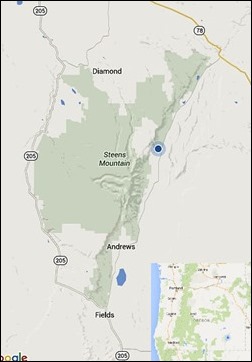 Steen’s Mountain is one of the very last formations at the upper northwest tip of the Great Basin geological area. It’s a 35-mile-long fault block, which means it’s a piece of the earth’s crust which cracked and became displaced upward.
Steen’s Mountain is one of the very last formations at the upper northwest tip of the Great Basin geological area. It’s a 35-mile-long fault block, which means it’s a piece of the earth’s crust which cracked and became displaced upward.
It’s also located in one of the lonelier places in the U.S. Oregon’s Harney County, one of the largest counties in the U.S., has only 7,500 residents, 2,800 of which live in Burns. There are a lot of ranches scattered around the county, with attendant private lands — but a huge percentage of this part of Oregon is public land, administered by the Federal Bureau of Land Management. This agency is known both fondly and hatefully (depends on who you are) as the BLM.
BLM land is a profound blessing to RV boondockers, people like us who would like to find some solitude and stay there for a while without bother or cost. Because it’s publicly “owned”, BLM land is generally available for camping with few or no restrictions.
Our first camp near Steen’s is a typical example. We camped at a BLM-designated facility at Mann Lake. It has some flat spots, two pit toilets, and the lake — that’s it. No power, no water, no host, no frills. No fees either at Mann Lake, but some BLM facilities charge anywhere from $6-$16 per night. Still pretty cheap compared to other RV camping options, and the peace and quiet are splendid.
Well, it should be said that the weather can sometimes have an adverse effect on the “quiet” part of that description. For several days, we experienced thunderstorms, pounding rains, and gale-force winds on and off throughout the days and nights. We were SO happy for Howie’s comforts. We were also happy for the astounding cell service in this locale — three bars of 4G is an amazing level of connection, all the more appreciated as we shamelessly cowered inside Howie while the intemperance raged outside our windows. It’s not a bad way at all to hunker down and wait for better weather. Here are two shots of our “front yard” (the lake) and “back yard” (the mountain).
During occasional lulls in the weather, we managed to sneak outside and enjoy several features around us. The first was the pelicans.
Mann Lake is part of the vast Pacific Flyway migration system, and in this month of May, a modest flock of white pelicans were in residence on the lake. They were quite skittish, and seemed to be active and photogenic only with the sun behind them. So all of my photos are long telephoto shots, back-lit with crummy contrast. Oh well, it was still fun watching and taking snapshots of these charismatic birds.
Unlike the grey pelicans that are so common along the Pacific shoreline near our home, the whites are (of course) lightly colored, with somewhat larger bills. The bills at this time of year were accentuated by an odd cookie-shaped projection on the top. These projections are grown during the mating season, and help prevent injury during the dominance sparring contests. They fall off after the breeding is over. I can’t help thinking of them as “pelican antlers”.
If I walked directly toward them, they’d fly away when I was still 200 yards away. It was only by “stalking” them — taking a few steps at a time, then stopping and holding still — that I was able to get within 50 yards or so. That was just barely close enough for my little 270mm telephoto. As I stood and watched them for a long time, I could see how their feeding habits worked. They’d stay together in a group and swim slowly around the lake’s shallows (never out in the middle). Every minute, or less, the oddest thing would happen — all the birds together would dunk their heads down into the water like so many synchronized swimmers. By no means would they all come up with a fish, but they would almost always all dunk at once. It was mysterious and comical at the same time.
The other thing that was fun to watch was their tendency to “yawn” — I can’t think of any other term. They’d point their bills at the sky and open them, flapping the skin of their gullet so the sun could shine through.
Finally, I crept up just one foot too close, and they all took off. This guy was the last to go, and gave me a nice fly-by shot.
Walking back from the lake’s edge, a little gopher snake belted out a huge hissing sound that scared the crap out of me. This is rattlesnake country, and the small brown snakes all look the same from a little distance. We’re way too far from medical help to risk a snake bite, so I was very cautious to properly identify the noisy fellow before I started taking pictures.
After the thunderstorms were done, the wind was still unmercifully brisk — like knock us off our feet gusty at times. But even so, we got a little bit of “cabin fever” on Sunday afternoon, and decided to go for a drive in Ralph. We headed further down the valley in the general direction of Mickey’s Hot Springs, which is at the upper edge of the Alvord Desert. The roads are dirt, but flat and easy. A little mud here and there, but no real obstacles.
We easily reached Mickey’s in 30 minutes or so. This tiny little feature is only a few acres, but it was as active as some of the stuff we’d seen in Yellowstone. Hissing, steaming vents and scalding-hot pools, all with the beautiful backdrop of the distant Steen’s range.
Karin almost blistered her hand checking the temperature of this inviting “swimming pool”. No way.
This smaller one was boiling like a teakettle.
None of the pools were even remotely near bathing temperature (unless you’re a lobster dinner), so we just had a good look around. Then, we decided to take a different route, an over-mountain road back to camp — not nearly so easy and straight as the valley road we came in on.
Shortly on our way, I just missed running over another snake. Careful check again, yup another gopher snake. This one was incredibly aggressive/defensive, hissing like one of the hot springs steam vents. We really had to work hard to chase him up off the road. Once he gave up the “I’m gonna bite you” fighting posture and switched to “let’s get out of here” flight mode, he moved so fast we could barely follow him.
Off up the nearby foothills we drove, now in 4WD and crawling over runoffs, small washouts, and lots of lava rocks. The road was a bit overgrown, indicating very low use, but it was, truth be told, not too bad. We’re always conscious of our vulnerability — a breakdown or stuck leaves us a LONG walk from nowhere. (The dirt “highway” that ran by camp had maybe 4-5 cars a day go by. Nearest medical or mechanical help would be Burns, 65 miles away.)
But the risks bring special rewards. The feeling of peace and solitude, the deep sense of satisfaction that comes with self-reliance, and of course the pure beauty of the countryside, this time adorned with spring wildflowers.
BLM land is typically multi-use land, and in this area it’s used for cattle grazing. We ran across this most unique and creative cattle watering “tank”, made from a giant earth-mover tire. The tire had been carefully and precisely sawn in half, then the center filled with concrete. What simple wisdom. It’s weather-proof, water-proof, and won’t bend if you run a truck or obnoxious steer into it. It will never rust out, or be stolen for metal scrap. Bullet-holes from irresponsible shooters are self-sealing. I guess its only detraction is that it is so heavy, it must have taken special equipment to put it in place.
Continuing back toward camp, there were a few spots where the mud got me a little nervous, and one stretch where we bush-whacked to go around a swampy spot. Then, in another area, another traveler had made new track to detour around a soupy spot. But in general, the road was not a big challenge, and we emerged through the last cattle gate to see the Steen’s escarpment across the valley.
Back home to Howie and another windy — but comfortable — night. Life is good.
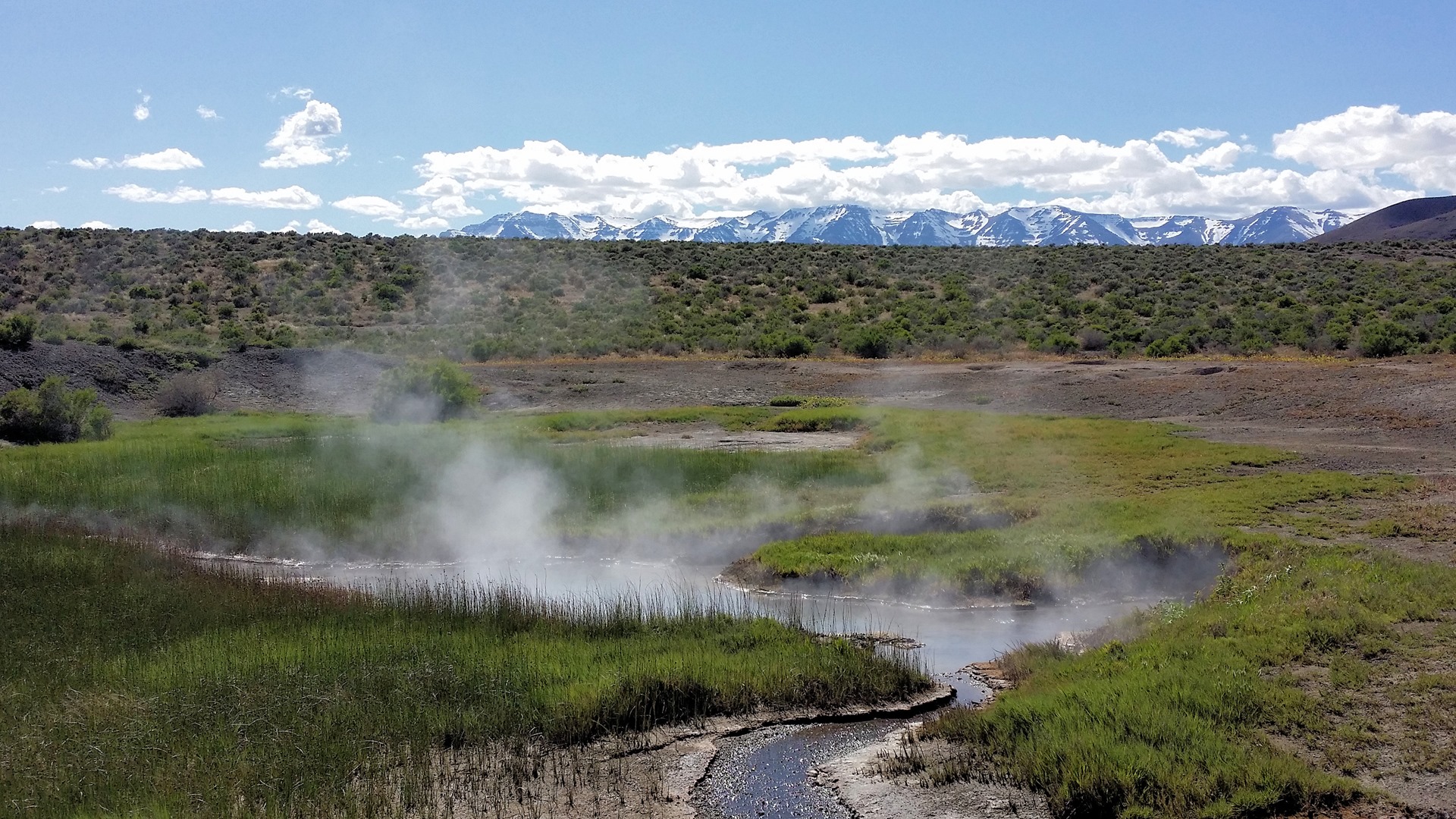
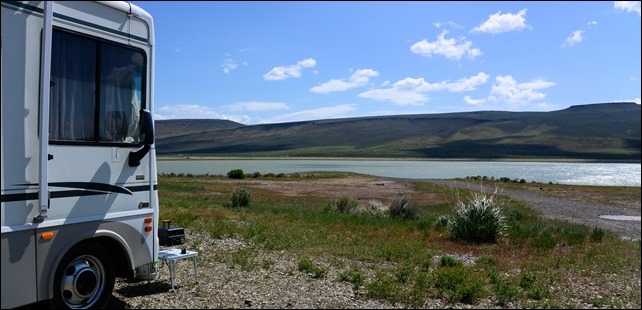
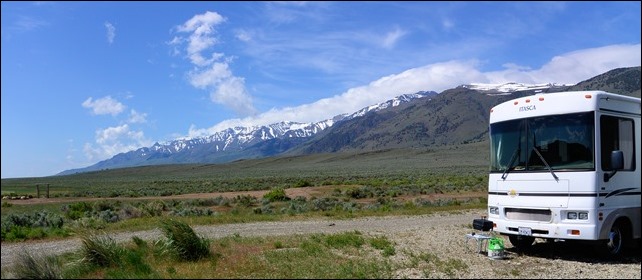
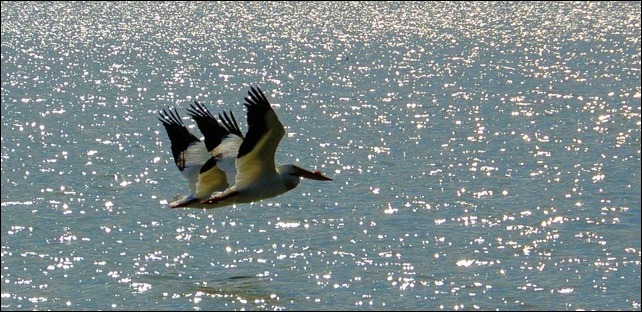
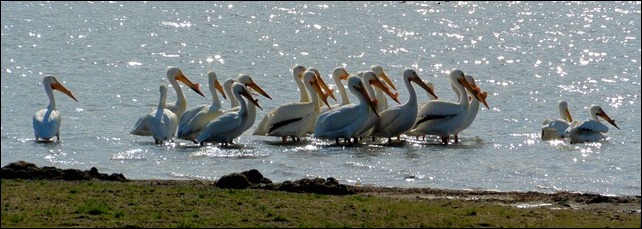


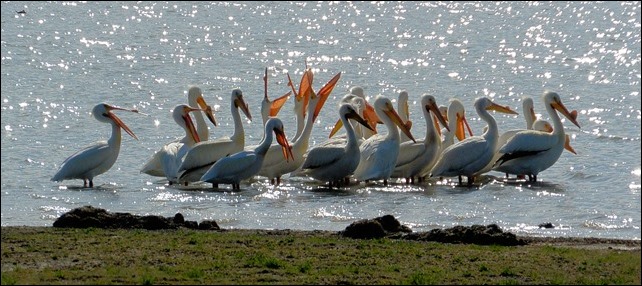
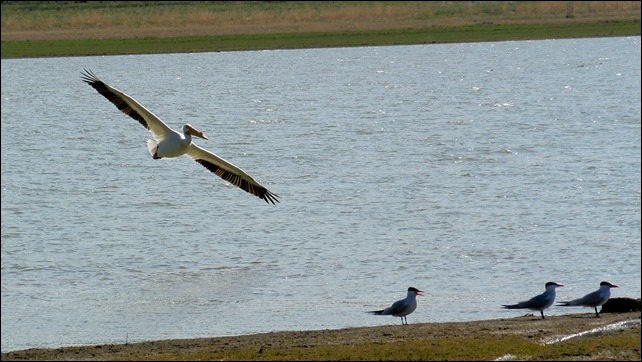
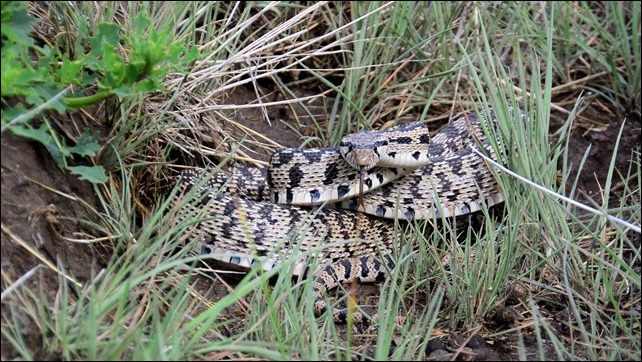

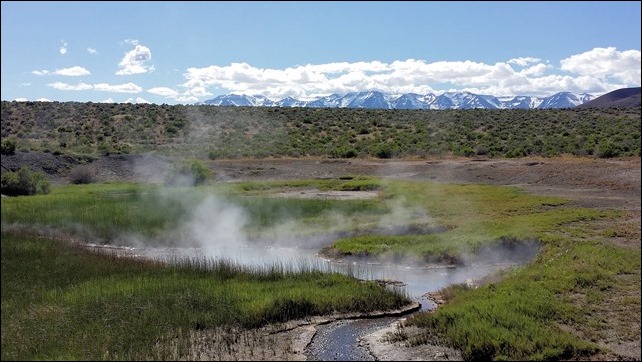
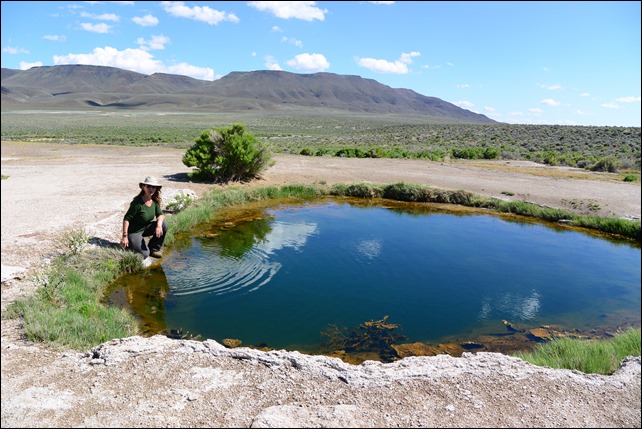
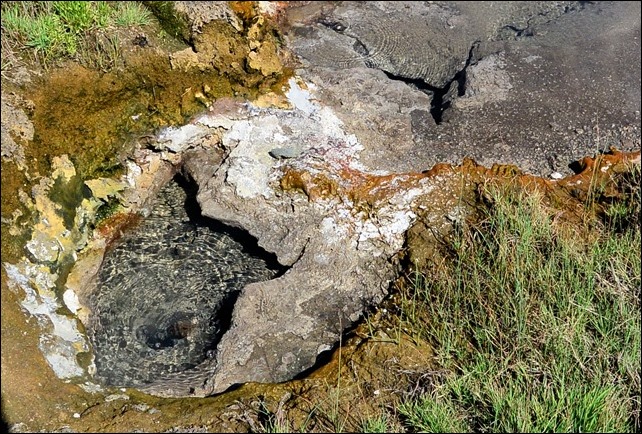
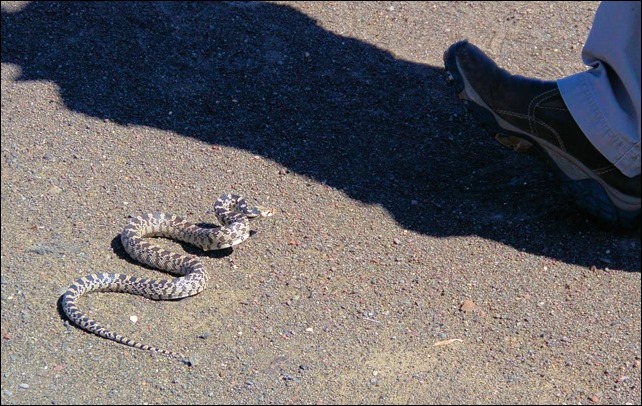
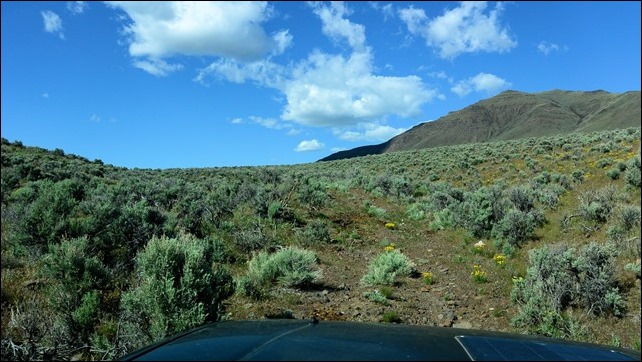
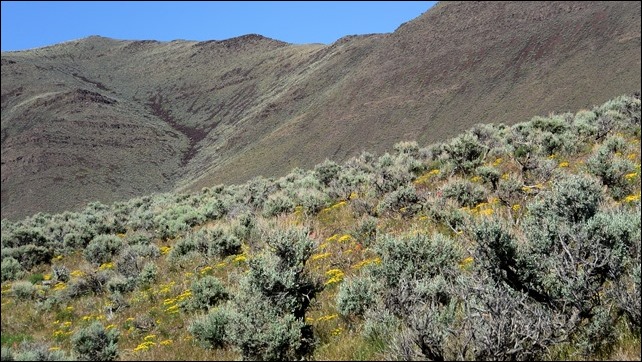
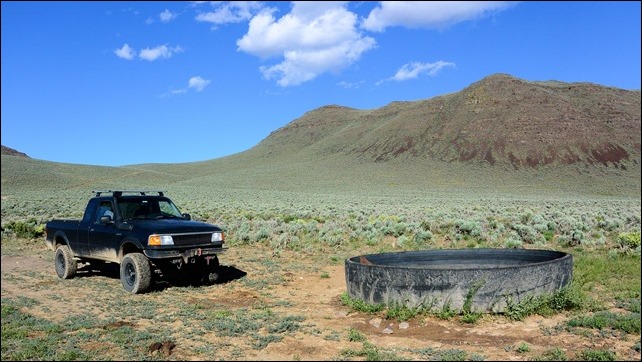
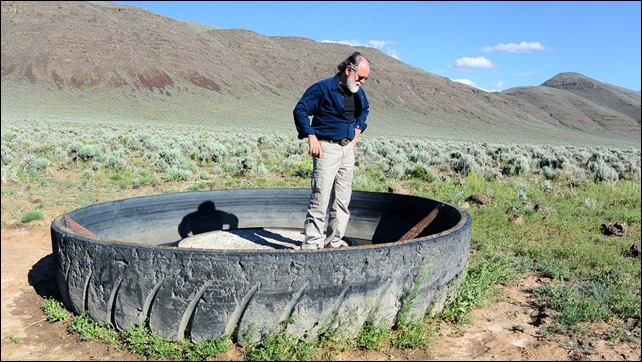
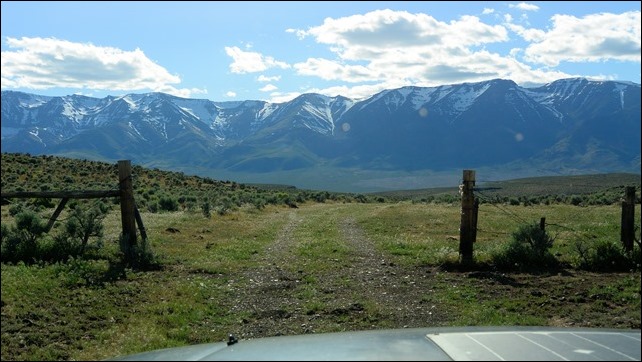
Some really beautiful scenery! I can’t believe how aggressive those gopher snakes were/ are. Usually, they flee- especially when they are out in the open and not cornered, Happy/ safe travels.
Wild & beautiful country! Thanks for sharing.